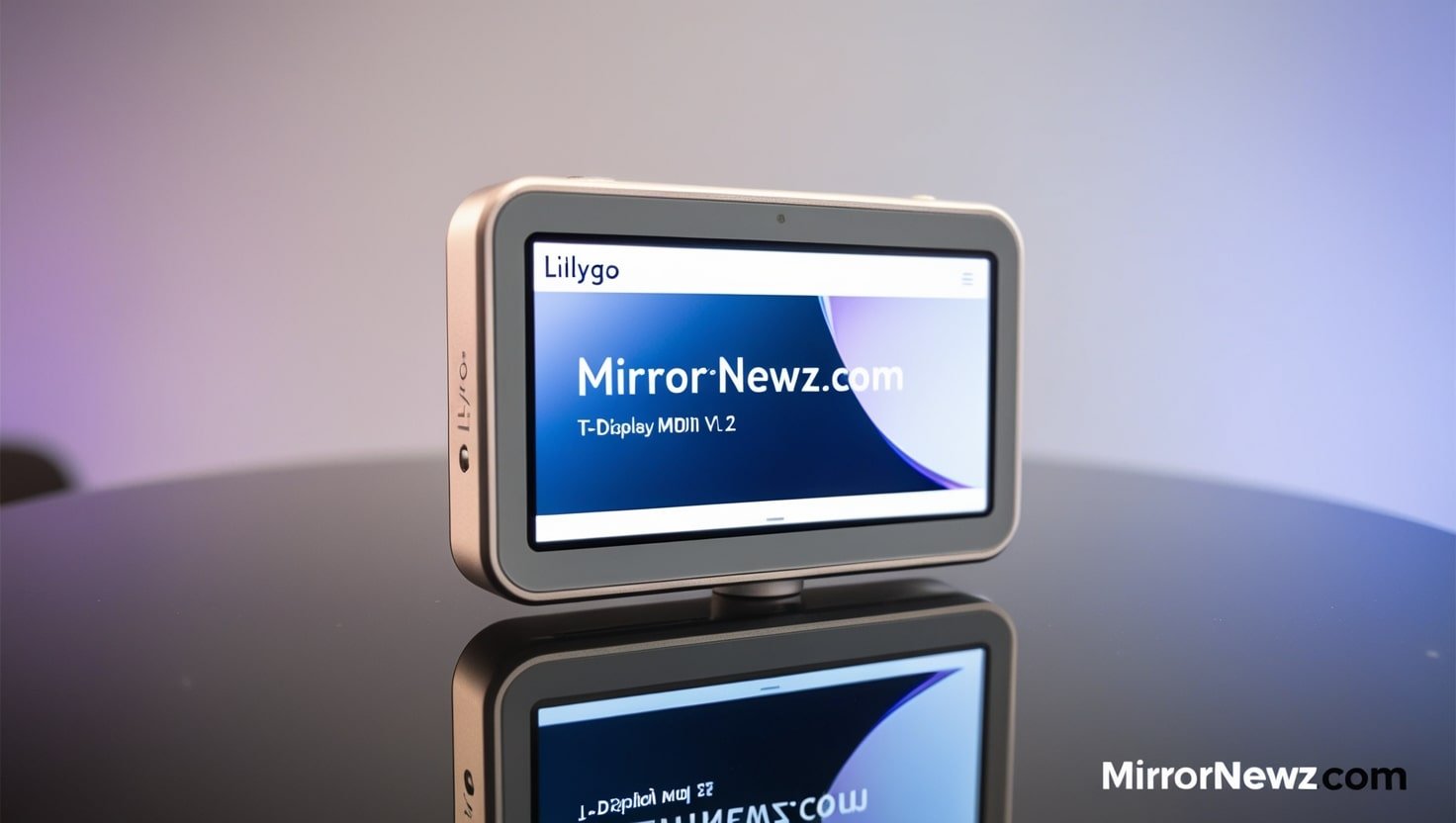In today’s world of electronic development, the Lilygo T Display sS3 Midi V1.2 stands as one of the most exciting innovations for hobbyists, engineers, and developers alike. This tiny device combines the power of a microcontroller with the flexibility of a display and MIDI functionality, opening up new doors for creative projects. Whether you’re building a musical instrument, an interactive art project, or simply exploring the capabilities of modern microcontrollers, the Lilygo T Display sS3 Midi V1.2 is a tool that promises to provide endless possibilities.
What is the Lilygo T Display sS3 Midi V1.2?
The Lilygo T Display sS3 Midi V1.2 is a development board that integrates the popular ESP32-S3 microcontroller with a small, high-quality TFT display and built-in MIDI capabilities. It is designed for anyone interested in creating applications that require a display, connectivity, and real-time control via MIDI. With its compact form factor, versatile features, and robust hardware, it provides a powerful platform for a wide range of projects.
Key Features of the Lilygo T Display sS3 Midi V1.2
One of the standout aspects of the Lilygo T Display sS3 Midi V1.2 is its hardware configuration. The board includes an ESP32-S3 processor, which is known for its power and versatility. This microcontroller supports Bluetooth and Wi-Fi, making it ideal for IoT applications. Furthermore, the device features a 1.14-inch TFT display that offers clear, vibrant visuals in a compact form, perfect for embedding into projects where space is limited.
In addition to the microcontroller and display, the Lilygo T Display sS3 Midi V1.2 is equipped with MIDI functionality. This makes it an excellent choice for those working with musical projects, whether it’s for controlling synthesizers, generating sounds, or even building a MIDI controller.
The Significance of MIDI in Modern Projects
MIDI, which stands for Musical Instrument Digital Interface, is a protocol that allows electronic instruments and devices to communicate with each other. It is widely used in the music industry, particularly in electronic music production, live performances, and sound design. By incorporating MIDI into the Lilygo T Display sS3 Midi V1.2, users can easily interface their microcontroller with other MIDI-compatible devices.
Whether you’re controlling virtual instruments on a computer, generating sound from a synthesizer, or creating interactive musical installations, MIDI opens up a world of creative possibilities. The integration of MIDI into the Lilygo T Display sS3 Midi V1.2 makes it an essential tool for anyone working in the field of music technology.
Getting Started with the Lilygo T Display sS3 Midi V1.2
For those who are new to working with development boards, getting started with the Lilygo T Display sS3 Midi V1.2 can seem daunting. However, the process is straightforward, and with some basic knowledge of electronics and programming, you can begin creating your own projects quickly.
First, you’ll need to set up the development environment. The Lilygo T Display sS3 Midi V1.2 is compatible with the Arduino IDE, which is one of the most popular platforms for programming microcontrollers. By installing the appropriate libraries and selecting the correct board from the IDE, you can begin coding and uploading sketches to your device.
Once the environment is set up, you can start exploring the features of the Lilygo T Display sS3 Midi V1.2. The TFT display can be used to show status messages, data, or even interactive graphics, while the MIDI interface allows you to send and receive MIDI signals to other devices. The ESP32-S3’s Bluetooth and Wi-Fi capabilities also enable wireless communication, opening up even more creative possibilities.
How MIDI Integration Enhances the Lilygo T Display sS3 Midi V1.2
The MIDI functionality of the Lilygo T Display sS3 Midi V1.2 is what truly sets it apart from other development boards. MIDI signals are transmitted over a variety of mediums, including USB, Bluetooth, and traditional 5-pin DIN connectors. With the Lilygo T Display sS3 Midi V1.2, you can connect your board to a variety of MIDI-compatible devices, such as keyboards, synthesizers, or even other microcontrollers.
The integration of MIDI allows for real-time control over musical elements, which is crucial for live performances or interactive installations. For example, the board can be used to control the pitch, volume, or effects of a synthesizer, while the TFT display can provide visual feedback on the current settings. This seamless combination of hardware and software makes the Lilygo T Display sS3 Midi V1.2 an invaluable tool for MIDI-based projects.
Creative Uses for the Lilygo T Display sS3 Midi V1.2
The possibilities for creative projects with the Lilygo T Display sS3 Midi V1.2 are virtually endless. Here are some ideas to spark your imagination:
- MIDI Controller: Create a custom MIDI controller with knobs, sliders, and buttons. The TFT display can show real-time values, while the MIDI functionality allows you to send control messages to other devices.
- Interactive Music Display: Build an interactive installation where users can control sound and visuals by interacting with the Lilygo T Display sS3 Midi V1.2. For example, a user could adjust sound parameters by touching the display or rotating a knob connected to the board.
- Sound Generators: Use the Lilygo T Display sS3 Midi V1.2 to create a compact, standalone sound generator that can send MIDI messages to synthesizers or digital audio workstations.
- Bluetooth MIDI Interface: Leverage the ESP32-S3’s Bluetooth capabilities to create a wireless MIDI interface, allowing you to control instruments remotely from a smartphone or tablet.
The Role of the TFT Display in MIDI Projects
While MIDI is the primary focus of the Lilygo T Display sS3 Midi V1.2, the built-in TFT display plays a crucial role in providing user feedback. The display can be used to show a variety of information, such as:
- MIDI Data: Display MIDI messages, such as note-on/off events, velocity, and control changes.
- Settings and Parameters: Show the current settings of your MIDI controller or sound generator, allowing you to tweak values in real-time.
- Visualization: Use the display to create visual feedback that corresponds to the music being played or the controls being adjusted. This can be particularly useful for live performances or interactive installations.
The integration of a TFT display with MIDI functionality creates a more intuitive and engaging experience for the user, allowing them to interact with their project in new and exciting ways.
Programming the Lilygo T Display sS3 Midi V1.2
Programming the Lilygo T Display sS3 Midi V1.2 is a straightforward process, especially for those familiar with the Arduino environment. The board comes with libraries that make it easy to communicate with the display and MIDI interfaces.
To get started, you’ll need to install the necessary libraries for both the TFT display and MIDI functionality. Once the libraries are set up, you can begin writing code to interact with the hardware. For example, you can write a sketch that reads MIDI signals from a connected keyboard and displays the note values on the screen. Alternatively, you can create a custom user interface that allows you to adjust MIDI parameters using on-screen buttons or sliders.
The ESP32-S3 microcontroller also supports advanced features such as multitasking and real-time processing, which can be useful for more complex projects. Whether you’re building a simple MIDI controller or a more sophisticated musical instrument, the Lilygo T Display sS3 Midi V1.2 gives you the flexibility and power you need to bring your ideas to life.
The Future of the Lilygo T Display sS3 Midi V1.2 in DIY Electronics
The Lilygo T Display sS3 Midi V1.2 represents the convergence of multiple technologies, including microcontrollers, displays, and MIDI. This combination makes it an ideal choice for anyone interested in exploring the intersection of music, electronics, and interactivity. As the demand for MIDI-based projects continues to grow, the Lilygo T Display sS3 Midi V1.2 is likely to become an even more essential tool for developers and creators.
Looking ahead, we can expect to see more innovative uses of the Lilygo T Display sS3 Midi V1.2 in areas such as music performance, sound design, and interactive art. The ability to integrate MIDI with other sensors, interfaces, and displays opens up a world of possibilities for both professionals and hobbyists.
Conclusion
The Lilygo T Display sS3 Midi V1.2 is a powerful and versatile tool that is perfect for anyone looking to create projects that involve MIDI, displays, and microcontrollers. With its compact form factor, intuitive display, and robust hardware, it offers an excellent platform for exploring the world of MIDI and electronic music. Whether you’re a seasoned developer or just starting out, the Lilygo T Display sS3 Midi V1.2 is an invaluable tool that can help bring your creative ideas to life.


